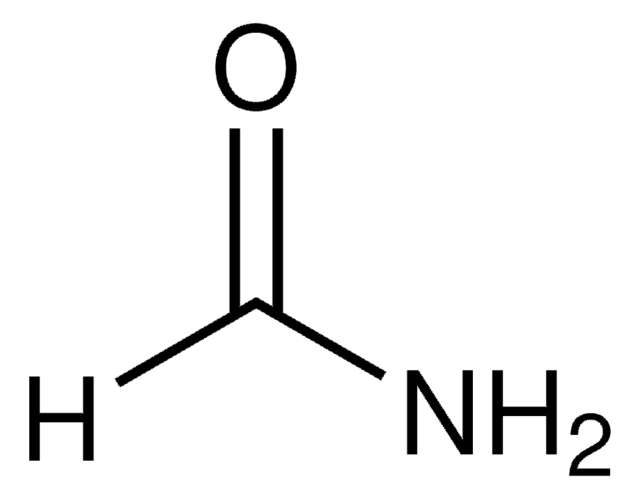87718
Tetramethylammonium chloride
BioUltra, for molecular biology, ≥99.0% (AT)
Synonym(s):
TMA
About This Item
Recommended Products
grade
for molecular biology
Quality Level
product line
BioUltra
assay
≥99.0% (AT)
form
crystals
impurities
DNases, none detected
RNases, none detected
insoluble matter, passes filter test
phosphatases, none detected
proteases, none detected
mp
>300 °C (lit.)
solubility
H2O: 6 M at 20 °C, clear, colorless
anion traces
bromide (Br-): ≤500 mg/kg
sulfate (SO42-): ≤50 mg/kg
cation traces
Al: ≤5 mg/kg
As: ≤0.1 mg/kg
Ba: ≤5 mg/kg
Bi: ≤5 mg/kg
Ca: ≤10 mg/kg
Cd: ≤5 mg/kg
Co: ≤5 mg/kg
Cr: ≤5 mg/kg
Cu: ≤5 mg/kg
Fe: ≤5 mg/kg
K: ≤50 mg/kg
Li: ≤5 mg/kg
Mg: ≤5 mg/kg
Mn: ≤5 mg/kg
Mo: ≤5 mg/kg
Na: ≤50 mg/kg
Ni: ≤5 mg/kg
Pb: ≤5 mg/kg
Sr: ≤5 mg/kg
Zn: ≤5 mg/kg
λ
1 M in H2O
UV absorption
λ: 260 nm Amax: 0.02
λ: 280 nm Amax: 0.02
SMILES string
[Cl-].C[N+](C)(C)C
InChI
1S/C4H12N.ClH/c1-5(2,3)4;/h1-4H3;1H/q+1;/p-1
InChI key
OKIZCWYLBDKLSU-UHFFFAOYSA-M
Looking for similar products? Visit Product Comparison Guide
Application
- Estimating the nonideality of eutectic systems containing thermally unstable substances.: The paper explores the use of Tetramethylammonium chloride in studying the non-ideal behavior of eutectic mixtures, contributing to better thermal management in material science and engineering (Minceva M et al., 2023).
- Natural deep eutectic solvents as thermostabilizer for Humicola insolens cutinase.: This study examines how Tetramethylammonium chloride-based eutectic solvents can stabilize enzymes, enhancing their practical applications in biotechnological processes (Sisti L et al., 2023).
Other Notes
signalword
Danger
hcodes
Hazard Classifications
Acute Tox. 2 Oral - Acute Tox. 3 Dermal - Aquatic Chronic 2 - Skin Irrit. 2 - STOT SE 1 Oral
target_organs
Central nervous system
Storage Class
6.1A - Combustible acute toxic Cat. 1 and 2 / very toxic hazardous materials
wgk_germany
WGK 3
ppe
Eyeshields, Faceshields, Gloves, type P2 (EN 143) respirator cartridges
Certificates of Analysis (COA)
Search for Certificates of Analysis (COA) by entering the products Lot/Batch Number. Lot and Batch Numbers can be found on a product’s label following the words ‘Lot’ or ‘Batch’.
Already Own This Product?
Find documentation for the products that you have recently purchased in the Document Library.
Customers Also Viewed
Our team of scientists has experience in all areas of research including Life Science, Material Science, Chemical Synthesis, Chromatography, Analytical and many others.
Contact Technical Service



